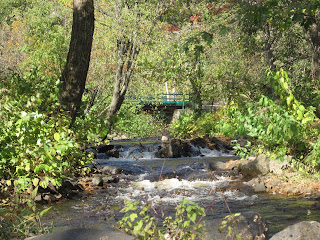Date of canoeing was oct 10th. This blog is just to illustrate how much the Laurentian mountains as to offer in terms of small river canoeing even up to low water season (sept-oct-nov). This is even more surprising given that this summer was very dry. How is that possible? It is because the Laurentian mountains physical geography are all of natural cuvettes that makes it easy to make reservoirs by creating a dam on small rivers. Most of the Laurentian lakes are therefore not lakes but reservoirs (created when logging was the main economical activity in the Laurentian mountains). Most of the locals have forgotten that since there is almost no more logging now and a lot of locals are shocked when someone talk about their lakes as being reservoirs. So choosing a small river that has a reservoir upstream in the Laurentian mountains makes that river an almost sure bet for canoeing even late in the season. The only drawback is that most topographical maps does not have a resolution of slopes high enough to choose apparently flat sections that translates into reality. My maps are 1: 250 000 resolution. Topo. maps are still the best for rapid analysis of a large geographical area. Googlemap is nice when you already know were to zoom in. Here is an exemple of a flat section at only 30-35 min drive from downtown Montreal where the Laurentian mountains starts. The small river is called Abercromby and is water fed by ''lake'' Connelly. The river is reachable at around 5 km north of the village of New Glasgow (where am I? United Kingdom?) on route 158 east. The Abercromby river is ultimately a 3rd degree tributary of the St-Lawrence river. I parked at the Y shape corner made of Chemin Abercrombie and Chemin de l'Achigan (two cars can fit only on the north arm of the Y shape corner). Here are some pictures.
Above: Uncharted area of Abercromby river section described below. Colored code map is from canoeing association Fédération Québecoise de Canot-Camping.
Above: Canoe landing across parking spot on the Y shape corner. There is a small concrete bridge on the right in this picture. Slope steep but manageable. Canoe landing on the other side not possible because of No Trespassing sign (Défence de passer sign).
Above: Going downstream from the bridge not a good gamble. Too rocky after the bridge. My gamble for a flat section did not start well that day. Tried upstream.
Above: After passing a small rocky section upstream the bridge with feet in the water the gamble paid off. The flat section I was hoping for.
Above: Cant believe how much water there is in this small river in low-water season. Without its upstream ''lake'' for sure this river would not be canoeable in october.
Above: This stretch of the river is in urban area and as usual most of the houses on waterfronts in the Laurentian mountains are discrete.
The river is cut in three sections here. Must be because of an old abandoned beaver dam which was engulfed by the vegetation.
Above: Being solo made me capable to not put my feet in the flat section of the tiny river ounce even in only a few inches of water. Of course I use my paddle more like a pushing stick in those situations.
Above: This was expected at one point. Cant be flat for too long in the Laurentian mountains. But this was still a lot of fun. Very technical. No beaver dam (always a possibility, but are normally easily manageable by flash portage). Also, it always help to bring a small compact saw to saw your way into fallen and tangled branches found typically on those tiny rivers.






















